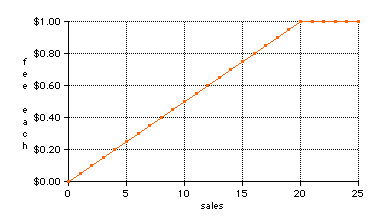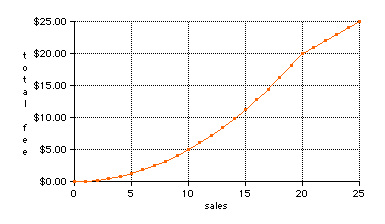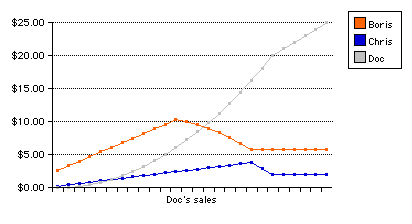Paying promoters
The Creators set the price of the work, including the promotion fee, and the sales target for each cycle. If the Promoter meets the sales target by the deadline, he earns the promotion fee in full for every sale. If not, the Creator keeps some of the money.
The promotion fee paid when the target isn't met is the ratio of the number of sales to the target, multiplied by the number of sales.
| This chart shows the promotion fee paid per sale with a sales target of 20 units and a promotion fee of $1.00 for sales between 0 and 25 |  |
| This chart shows the total promotion fee paid for all sales with a sales target of 20 units and a promotion fee of $1.00 for sales between 0 and 25 |  |
In the simplest case with a creator, a promoter and a customer, this is how it works. You could achieve a simple one stage fee by setting the sales target to 1 unit. However, as each customer can become a promoter, we need a way to chain promoters and reward them accordingly, without causing them to compete in destructive ways.
Customers can become Promoters
The idea is that each promoter is rewarded for the total value of all sales they or their customers make. Any promotion fees earned between them and the ultimate customer are subtracted from this. The reward function is designed to ensure that cutting out upstream promoters gains you nothing.
In the other direction, you gain more from a sale you make directly than one your customer makes, but sales your customers make increase the overall reward for your other sales.
As the total price is fixed, the customer has no incentive to shop around between the different people in the chain, and as the downline payment is independent of how many are in the upline, there is no incentive to 'cut out the middleman' and distribute straight from the artist either. The artist has a slight incentive to go direct, but if they set the promotional fee at a sensible level they get the bulk of the fee per client anyway, so this effect is diluted.
There is an incentive to have a shorter, wider structure rather than longer chain, as the reward from downline redistribution is the difference between your total, and that of the branch, so the rewards go predominantly to those who spread it widest.
A worked example - sales target not met
Andrew makes a movie, and sets his fee to $4, the promotion fee to $1 (so each customer pays $5) and the sales target to 20 for the month.
Boris buys a copy and promotes it. He persuades Carol and Christopher to buy a copy each. Carol gets 5 of her friends to buy it, Christopher gets Doc and Dave to buy a copy.
Each customer pays $5 - total revenue is (1+2+5+2) x 5 = $50
Andrew receives $40 straight away (or rather $4 with each sale). At the end of the month we calculate sales:
Total sales 10. Sales target 20.
As root promoter, Boris made all 10 of these, so he gets 10 x 10/20 x$1 = $5. The remaining $5 goes to Andrew.
Carol made 6 sales, so she gets 6 x 6/20 x $1 = $1.80
Christopher made 3, so he gets 3 x 3/20 x $1 = $0.45
Carol and Christopher's fees are subtracted from Boris's $5, leaving him with $5.00 - $2.25 = $2.75 Andrew's total is $45
A worked example - sales target met
If you hit the sales target, it saturates, which means that the promoter gets the full fee for each sale. If Doc posts a link to the movie on his weblog and 25 people buy it, how does that change things?
Total sales 35. Sales target 20.
Each customer pays $5 - total revenue is (1+2+5+2+25) x 5 = $175
Andrew receives $140 straight away (or rather $4 with each sale). At the end of the month we calculate sales:
As root promoter, Boris made all 35 of these, so he get 35*$1 = $35. As the target was hit, Andrew retains no promotion fee.
Carol made 6 sales, so she gets 6 x 6/20 x $1 = $1.80
Christopher made 28, so he gets 28 x $1 = $28
Doc made 26, so he gets 26 x $1 = $26
Carol and Christopher's fees are subtracted from Boris's $35, leaving him with $35.00 - $29.80 = $5.20
Doc's fees are subtracted from Christopher's $28, leaving him with $28 - $26 = $2.00 Andrew's total is $140
In either case, Andrew would pay his hosting costs and a small percentage service fee per sale.
No need to cut out middlemen
The more astute among you will have noticed that the promoter's reward curve has flattened off here - any further sales Doc makes will net him the full promotion fee, and Christopher and Boris make nothing further from them. In fact, Christopher and Boris would have done better if Doc hadn't hit the target at all, but had caused them to do so instead.
| This chart shows the total promotion fee paid to Boris, Christopher and Doc with a sales target of 20 units and a promotion fee of $1.00 for Doc's sales between 0 and 25 |  |
This at first looks anomalous, and implies it may give perverse incentives to Boris and Christopher about making sales. In practice, at this point any further sales they make themselves, or through other will be rewarded at the full promotional fee. The way that money moves towards those who make the actual sales target is by design, and the adverse affect on pure middlemen is to encourage them to make sales themselves, or go and create something and sell it. If they lobby Andrew to increase their sales targets next month, in the hope of Doc not meeting them this time, this is a mostly benign effect; as the sales records are public, Andrew is well aware who is making most sales for him.
Copyright Kevin Marks 2001-2002

